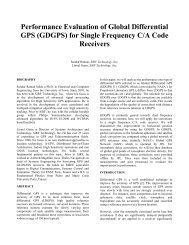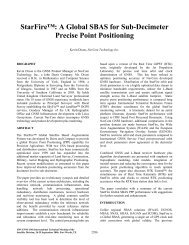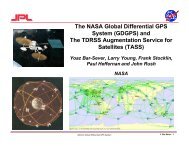Real-time kinematic positioning with NASA's Internet-based ... - gdgps
Real-time kinematic positioning with NASA's Internet-based ... - gdgps
Real-time kinematic positioning with NASA's Internet-based ... - gdgps
Create successful ePaper yourself
Turn your PDF publications into a flip-book with our unique Google optimized e-Paper software.
North East Height<br />
mean stdev mean stdev mean stdev<br />
full -0.7 28.6 17.6 15.7 -20.4 64.9<br />
w/o init 0.0 9.8 21.2 13.3 -22.4 32.3<br />
Table 4: Mean and standard deviation of position differences, in cen<strong>time</strong>ter, in <strong>kinematic</strong> test. Satellite cut-off<br />
elevation angle is 15 degrees.<br />
As expected, augmentation of the minimal elevation angle weakens the satellite geometry. This immediately led<br />
to some degradation of the accuracy of the boat position estimates (cf. table 3).<br />
Figure 3: Coordinate <strong>time</strong> series for the receiver<br />
onboard the boat in the <strong>kinematic</strong> test<br />
corresponding to strategy B from table 5.<br />
Figure 4: Coordinate <strong>time</strong> series for the receiver<br />
onboard the boat in the <strong>kinematic</strong> test<br />
corresponding to strategy A from table 5.<br />
5. Effect of troposphere estimation on the <strong>kinematic</strong> <strong>positioning</strong><br />
The GIPSY-OASIS II software is able to estimate both the wet troposphere (zenith wet delays) and the<br />
troposphere gradients. These parameters are modelled as either constant (bias) parameters over a whole<br />
observation <strong>time</strong> span or stochastic parameters driven by a random process noise. Additional investigations have<br />
been made on the PPP processing strategy for <strong>kinematic</strong> data, in order to assess the impact of various strategies<br />
of troposphere estimation on filter convergence and <strong>kinematic</strong> <strong>positioning</strong> accuracy. The importance of these<br />
investigations stems from the fact that the Height component of a receiver’s position, the receiver clock error and<br />
the wet zenith delay (and gradients), tend to be highly correlated. We experimented <strong>with</strong> a number of estimation<br />
strategies and selected those that demonstrated the best single receiver <strong>kinematic</strong> <strong>positioning</strong> performance. The<br />
estimation strategies we experimented <strong>with</strong> are outlined in table 5.<br />
strategy description<br />
A wet troposphere is estimated as a constant; trop. gradients are not estimated<br />
B both wet troposphere and trop. gradients are estimated stochastically<br />
C wet troposphere is estimated stochastically; trop. gradients are not estimated<br />
D wet troposphere is estimated as a constant; trop. gradients are estimated stochastically<br />
Table 5: Differences between tested PPP estimation strategies.<br />
strategy standard deviations convergence <strong>time</strong><br />
North East Height min<br />
A 6.2 14.2 15.8 20<br />
B 8.0 12.3 20.3 40<br />
C 6.7 12.9 23.6 40<br />
D 7.1 12.7 19.8 40<br />
Table 6: Standard deviation of position differences, in cen<strong>time</strong>ter (filter convergence is left out), and filter<br />
convergence <strong>time</strong>, in minutes, for the strategies described in table 5.





